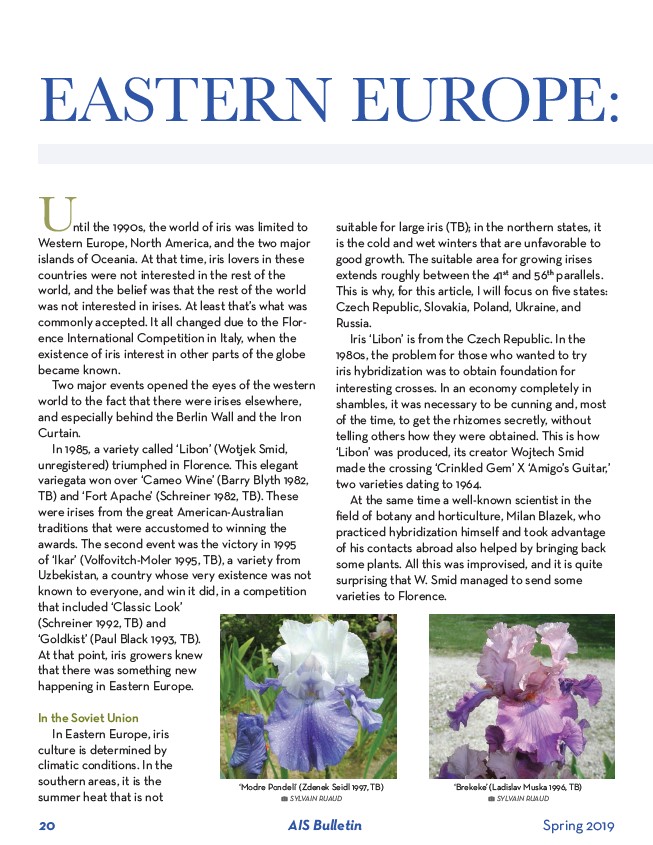
EASTERN EUROPE: ‘Brekeke’ (Ladislav Muska 1996, TB)
Until the 1990s, the world of iris was limited to
Western Europe, North America, and the two major
islands of Oceania. At that time, iris lovers in these
countries were not interested in the rest of the
world, and the belief was that the rest of the world
was not interested in irises. At least that’s what was
commonly accepted. It all changed due to the Florence
International Competition in Italy, when the
existence of iris interest in other parts of the globe
became known.
Two major events opened the eyes of the western
world to the fact that there were irises elsewhere,
and especially behind the Berlin Wall and the Iron
Curtain.
In 1985, a variety called ‘Libon’ (Wotjek Smid,
unregistered) triumphed in Florence. This elegant
variegata won over ‘Cameo Wine’ (Barry Blyth 1982,
TB) and ‘Fort Apache’ (Schreiner 1982, TB). These
were irises from the great American-Australian
traditions that were accustomed to winning the
awards. The second event was the victory in 1995
of ‘Ikar’ (Volfovitch-Moler 1995, TB), a variety from
Uzbekistan, a country whose very existence was not
known to everyone, and win it did, in a competition
that included ‘Classic Look’
(Schreiner 1992, TB) and
‘Goldkist’ (Paul Black 1993, TB).
At that point, iris growers knew
that there was something new
happening in Eastern Europe.
In the Soviet Union
In Eastern Europe, iris
culture is determined by
climatic conditions. In the
southern areas, it is the
summer heat that is not
suitable for large iris (TB); in the northern states, it
is the cold and wet winters that are unfavorable to
good growth. The suitable area for growing irises
extends roughly between the 41st and 56th parallels.
This is why, for this article, I will focus on five states:
Czech Republic, Slovakia, Poland, Ukraine, and
Russia.
Iris ‘Libon’ is from the Czech Republic. In the
1980s, the problem for those who wanted to try
iris hybridization was to obtain foundation for
interesting crosses. In an economy completely in
shambles, it was necessary to be cunning and, most
of the time, to get the rhizomes secretly, without
telling others how they were obtained. This is how
‘Libon’ was produced, its creator Wojtech Smid
made the crossing ‘Crinkled Gem’ X ‘Amigo’s Guitar,’
two varieties dating to 1964.
At the same time a well-known scientist in the
field of botany and horticulture, Milan Blazek, who
practiced hybridization himself and took advantage
of his contacts abroad also helped by bringing back
some plants. All this was improvised, and it is quite
surprising that W. Smid managed to send some
varieties to Florence.
, SYLVAIN RUAUD
‘Modre Pondeli’ (Zdenek Seidl 1997, TB)
, SYLVAIN RUAUD
20 AIS Bulletin Spring 2019